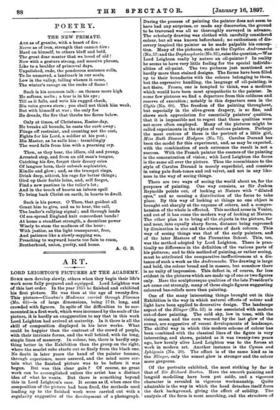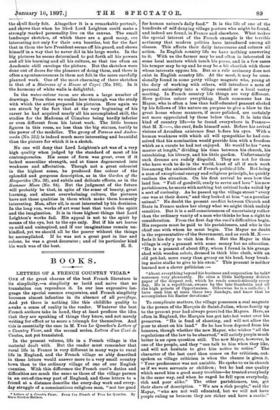ART.
LORD LEIGHTON'S PICTURES AT THE ACADEMY.
Sonic men develop slowly, others when they begin their life's work seem fully prepared and equipped. Lord Leighton was of this last order. In the year 1855 he finished and exhibited his first picture. He was then at the age of twenty-five. This picture—Ciniabue's Madonna carried through Florence (No. 65)—is of large dimensions, being 17 ft. long, and crowded with figures. In spite of the difficulties to be sur- mounted in a first work, which were increased by the scale of the picture, it is hardly an exaggeration to say that in this work Lord Leighton had arrived at maturity. In it there is all the skill of composition displayed in his later works. What could be happier than the contrast of the crowd of people, with their intricate forms, and the wall behind, with its long, simple lines of masonry. In colour, too, there is hardly any. thing better in the Exhibition than the group on the right, where the scarlet robe starts out so finely from the black one. No doubt in later years the hand of the painter became, through experience, more assured, and the mind more cer- tain what the finished picture was to be before it was began. But was this clear gain ? Of course, no great work can be accomplished unless the artist has a distinct idea of what he wants. But there is something beyond this in Lord Leighton's ease. It seems as if, when once the composition of the picture had been fixed, the methods used leading up to the finished work were carried out with a regularity suggestive of the development of a photograph. Daring the process of painting the painter does not seem to have had any surprises, or made any discoveries, the ground to be traversed was all so thoroughly surveyed in advance. The scholarly drawing was clothed with carefully considered colour, but all was known beforehand; no enthusiasm of dis- covery inspired the painter as he made palpable his concep- tion. Many of the pictures, such as the Captive Andromache (No. 57) and the Daphnephoria (No. 81), raise the question,—Was Lord Leighton really by nature an oil-painter? In reality he seems to have very little feeling for the special individu- alities of oil-paint. The two pictures just mentioned are hardly more than stained designs. The forms have been filled up to their boundaries with the colours belonging to them, but the expressive handling, the language of oil-painting, is not there. Fresco, one is tempted to think, was a medium which would have been most sympathetic to the painter. In some few pictures we find a departure from this coldness and reserve of execution ; notably is this departure seen in the Clytie (No. 60). The freedom of the painting throughout, but especially in the olive-green drapery, is so fine, and shows such appreciation for essentially painters' qualities, that it is impossible not to regret that those qualities were not more often employed. Many of the pictures might be called experiments in the styles of various painters. Perhaps the most curious of these is the portrait of a little girl,. Miss Ruth Stewart Hodgson (No. 72). Carolus Durand has been the model for this experiment, and, as may be expected,. with the combination of such extremes the result is not a success. With the French painter the essence of the painting is the concentration of vision ; with Lord Leighton the focus is the same all over the picture. Thus the resemblance to the style of Carolna Durand is merely superficial, and consists in using pale flesh-tones and red velvet, and not in any like- ness in the way of seeing things.
There are two ways of seeing the world about us, for the purposes of painting. One way consists, as Sir Joshua Reynolds points out, of looking at Nature with "dilated eyes," and so causing a distribution of the focus to take place. By this way of looking at things no one object is brought out sharply at the expense of others, and a compre- hension of the whole is effected. This method arose in Venice, and out of it has come the modern way of looking at Naturs. The other plan is to bring all the objects in the picture, far and near, into equally sharp focus, distance being expressed by diminution in size and the absence of dark colours. This way of seeing things was that of the early painters, and of the later Masters of the Florentine School. This, too, was the method adopted by Lord Leighton. There is prac- tically no difference in the definition of the various parts of his pictures; and to this method of painting, or rather seeing, must be attributed the comparative ineffectiveness at a dis- tance of such a work as the Andromache. The drawing is large and bold, the colour broad and in masses, but somehow there is no unity of impression. This defect is, of course, far less evident in the pictures which are made up of one or two figures only. Here the sculpturesque qualities of the late President's art come out strongly, many of these single figures suggesting coloured bas-reliefs more than painting.
One of the many interesting things brought out in this Exhibition is the way in which natural effects of colour and light have been applied to decorative design. The landscape aspect of the Slinger (No. 53) is one associated with modern out-of-door painting. The cold sky, low in tone, with the rising moon and the corn warmed by the last glow of the sunset, are suggestive of recent developments of landscape. The skilful way in which this modern scheme of colour has been combined with the classical lines of the figure is very interesting, and shows, painted as it was twenty-two years ago, how keenly alive Lord Leighton was to the forces at work in modern art. Another instance is the Cymon and Iphigenia (No. 20). The effect is of the same kind as is the Slinger, only the sunset glow is stronger and the colour more gorgeous.
Of the portraits exhibited, the most striking by far is that of Sir Richard Burton. Here the smooth painting and languid modelling have been put aside, and a vigorous character is revealed in vigorous workmanship. Quite admirable is the way in which the head detaches itself from the dark background, giving the effect of solidity. The analysis of the form is most searching, and the structure-of
the skull finely felt. Altogether it is a remarkable portrait, and shows that when he liked Lord Leighton could make a strongly ?narked personality live on the canvas. The small landscape sketches, of which there are a good many, ere interesting not only for their own beauties, but for the fact that in them the late President seems off his guard, and shows himself in a way that he never did in his large works. In the big pictures he seems determined to put forth all his powers and all his learning and all his culture, so that too often an Academic chill envelops the picture. But the sketches were 43one out of doors for the pleasure of doing them, and there is often a spontaneousness in them not felt in the more carefully planned work. One of the most charming of these sketches is that of a Staircase of a House at Capri (No. 186). In it the harmony of white walls is delightful.
In the water-colour room are shown a large number of drawings. From these we realise how thorough was the study with which the artist prepared his pictures. Here again we are struck by the fact that at the very beginning of his career he had acquired nearly all his accomplished skill, the studies for the Madonna of Cimabue being hardly inferior or even different from his latest work. The little bronze figures in this room, no leas than the big statues, testify to the power of the modeller. The group of Perseus and Andro- meda (No. 322) is indeed much more interesting and beautiful than the picture for which it is a sketch.
No one will deny that Lord Leighton's art was of a very high quality when judged by the standard of most of his contemporaries. His sense of form was great, even if it lacked masculine strength, and at times degenerated into weakness and affectation. Though not a great colourist in the highest sense, he produced fine colour of the splendid and gorgeous description, as in the Garden of the Hesperides (No. 39), and subtle and delicate effects, as in the Summer Moon (No. 84). But the judgment of the future will probably be that, in spite of the sense of beauty, great learning, and almost overwhelming culture, the pictures have not those qualities in them which make them humanly interesting. Man, after all, is most interested by his destinies. In the long run, works of art wear best that touch the spirit and the imagination. It is in these highest things that Lord Leighton's works fail. His appeal is not to the spirit by means of the eye, but to the eye only. But if his art leaves us cold and uninspired, and if our imaginations remain un- kindled, yet we should all be the poorer without the things he accomplished. If he was not a great poet in line and colour, he was a great decorator ; and of its particular kind







































 Previous page
Previous page